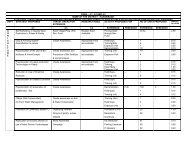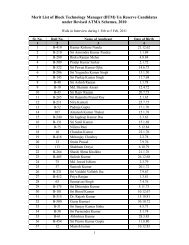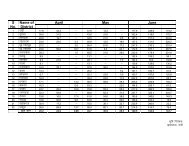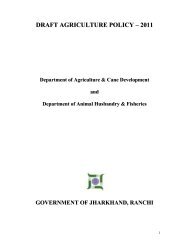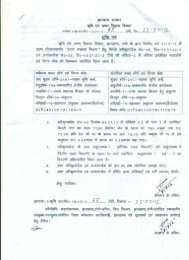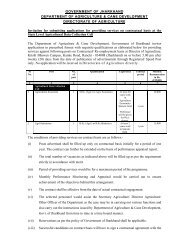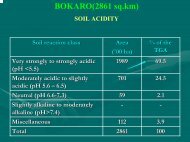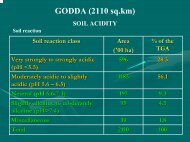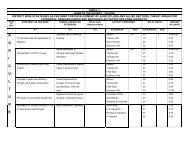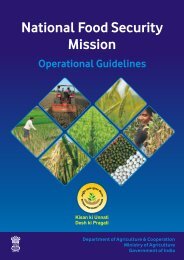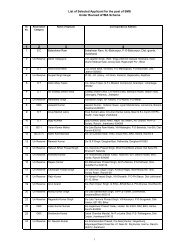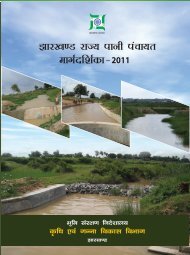Annual Report 2008-09 - Sameti.org
Annual Report 2008-09 - Sameti.org
Annual Report 2008-09 - Sameti.org
You also want an ePaper? Increase the reach of your titles
YUMPU automatically turns print PDFs into web optimized ePapers that Google loves.
SAMETI, JHARKHAND<br />
<strong>Annual</strong> <strong>Report</strong><br />
<strong>2008</strong>-<strong>09</strong><br />
STATE AGRICULTURAL MANAGEMENT & EXTENSION TRAINING INSTITUTE<br />
KRISHI BHAWAN CAMPUS, KANKE ROAD, RANCHI-834008<br />
PH – 0651-2232745, FAX- 0651-2232746<br />
EMAIL: sametijharkhand@rediffmail.com<br />
URL: www.sameti.<strong>org</strong><br />
<strong>Annual</strong> <strong>Report</strong> – <strong>2008</strong>-<strong>09</strong>
Sri. Sunil Kumar Tel - 0651-2232746<br />
Director Fax - 0651-2232746<br />
E Mail: sametijharkhand@rediffmail.com<br />
Foreword<br />
During the year ‘SAMETI’ has taken keen interest in identifying the gaps in<br />
Extension Reforms and adopts measures for improvement by <strong>org</strong>anizing<br />
several training programmes on Extension Management, Horticulture &<br />
Information Technology. The emphasis was to reach rural with farmer -<br />
scientist program.<br />
The <strong>Annual</strong> <strong>Report</strong> of SAMETI for the year <strong>2008</strong>-<strong>09</strong> demonstrates our<br />
continued commitment to the first rate of Extension Training in the State.<br />
Performance of SAMETI can be evaluated in terms of impact which<br />
over the years will reflects its commitment towards all round growth of<br />
agricultural development in the State.<br />
Sincere and dedicated efforts of Sri. Manoj Kabi, Faculty (I.T), Sri. Sunil<br />
Kumar Singh, Faculty (Horticulture) and Sri. Abhishek Tirkey, Faculty<br />
(Agril. Extn) in all activities of SAMETI is greatly acknowledged.<br />
April’<strong>09</strong><br />
(Sunil Kumar)<br />
<strong>Annual</strong> <strong>Report</strong> – <strong>2008</strong>-<strong>09</strong>
C O N T E N T S<br />
ACHIEVEMENTS SO FAR<br />
1. Background Information.......................................................................................................................................... 00<br />
2. <strong>Sameti</strong> & its Mandate................................................................................................................................................. 00<br />
3. Brief Agriculture Scenario of the State................................................................................................................ 00<br />
4. Resources Available.................................................................................................................................................... 00<br />
5. Training Programme Organized / Future Programme................................................................................... 00<br />
6. Faculty............................................................................................................................................................................. 00<br />
7. Training Methodology.............................................................................................................................................. 00<br />
8. Research-Extension-Farmer Linkage................................................................................................................... 00<br />
9. Publications .................................................................................................................................................................. 00<br />
10. Physical & Financial Progress.................................................................................................................................. 00<br />
11. Linkage With Institutions......................................................................................................................................... 00<br />
12. Process Introduced..................................................................................................................................................... 00<br />
13. Institutional Sustainability....................................................................................................................................... 00<br />
14. Task Ahead..................................................................................................................................................................... 00<br />
15. Future Challenges....................................................................................................................................................... 00<br />
16. <strong>Sameti</strong> in Print Media................................................................................................................................................ 00<br />
17. List of ATMA and their Address with Contact No............................................................................................. 00<br />
18. Kisan Call Centre - An Overview............................................................................................................................ 00<br />
19. Farm School Concept & Achievement................................................................................................................. 00<br />
20. Participation in Kisan Mela ..................................................................................................................................... 00<br />
21. Agriculture and Farmers Development Workshop-cum-Exhibitionn-Rabi <strong>2008</strong> ................................ 00<br />
22. Best ATMA Reward and Farmers Awards ........................................................................................................... 00<br />
23. Review Cum Experience Sharing Workshop for Eastern & North Eastern States................................. 00<br />
24. Post Graduate Diploma inn Agriculture Extension Management............................................................. 00<br />
25. Publication on Sale..................................................................................................................................................... 00<br />
26. Details of Registration of 14 New ATMA Districts............................................................................................ 00<br />
<strong>Annual</strong> <strong>Report</strong> – <strong>2008</strong>-<strong>09</strong>
ACHIEVEMENT SO FAR<br />
Under Support to State Extension Programme under Extension Reforms with the facilitation of<br />
SAMETI, Jharkhand, following milestones were achieved.<br />
1. Facilitated and documented the Strategic Research and Extension Plan (SREP) for 4 new<br />
ATMA district and for rest 14 ATMA districts draft SREP has been completed.<br />
2. Has documented its efforts through publication of leaflets, booklets and posters for<br />
effective and sustainable transfer of frontier agriculture technologies for the benefits of<br />
the farming community.<br />
3. As per the draft SREP of 14 new ATMA districts and 8 old ATMA districts, State<br />
Extension Work Plan 20<strong>09</strong>-10 and 2010-11 has been prepared and submitted to Govt.<br />
of India.<br />
4. Conducted Inter-State exposure visits for farmers of ATMA districts to Andhra Pradesh<br />
in PPP mode with CARD, New Delhi.<br />
5. Brought 76 publications so far for use by extension functionaries & farmers.<br />
6. Organized 133 training programme since 2003 benefiting over 7971 participants.<br />
7. SAMETI has been identified as Study Center for conducting Post Graduate Diploma in<br />
Agricultural Extension Management Course Sponsored by Govt. of India.<br />
8. Organized Regional level Review cum Experience Sharing workshop for eastern and<br />
north eastern states at Ranchi.<br />
9. During the year <strong>2008</strong>-<strong>09</strong>, a total 133 candidates were enrolled in the PGDAEM course<br />
under the SAMETI, Jharkhand (Study Center).<br />
10. 2 Best awarded farmers and one Agri-Entrepreneur were sent to IIM, Ahmedabad for<br />
Managerial Skill enhancement.<br />
11. ATMA, Dumka has been awarded as best ATMA district in Jharkhand followed by ATMA,<br />
West Singhbhum and ATMA, Hazaribagh under extension reforms programme.<br />
12. 150 progressive farmers (30 Women farmers) from 22 ATMA districts of Jharkhand<br />
have been awarded for their agricultural activities in the field.<br />
13. 5 regional Agriculture & Farmers Development Workshop cum Exhibition has been<br />
<strong>org</strong>anized at Ranchi, Dumka, Hazaribagh, West Singhbhum and Palamau region<br />
benefiting near about 36000 famers and others in the State.<br />
14. A total 18 farm school (including 4 in 2007-08) were established and operationalized<br />
at Dumka, Jamtara, West Singhbhum, Hazaribagh, Garhwa, and Seraikella during the<br />
year <strong>2008</strong>-<strong>09</strong>.<br />
15. One month massive publicity campaign for all central sector scheme like Extension<br />
Reforms, NFSM & RKVY through Radio Mantra 98.7 FM (Local FM Channel) at<br />
Ranchi.<br />
<strong>Annual</strong> <strong>Report</strong> – <strong>2008</strong>-<strong>09</strong>
1. Background Information :<br />
Economic reforms initiated since 1991 have put the Indian economy on a higher growth trajectory.<br />
<strong>Annual</strong> growth rate in the total Gross Domestic Product (GDP) has accelerated from below 6 per cent<br />
during the initial years of reforms to more than 8 percent in recent years. The Planning Commission in<br />
its approach paper to the Eleventh Five-Year-plan has stated that 9 per cent growth rate in GDP would<br />
be feasible during the Eleventh Plan period. However, Agriculture that accounted for more than 30 per<br />
cent of total GDP at the beginning of reforms failed to maintain its pre-reform growth. On the contrary,<br />
it witnessed a sharp deceleration in growth after the mid-1990s. This happened despite the fact that<br />
agricultural productivity in most of the states was quite low as it were, and the potential for the growth<br />
of agriculture was high.<br />
The State of Jharkhand was created in November’ 2000 after carving 79 lakh hectares geographical area<br />
from the State of Bihar for better planning and execution of development activities of a ecologically<br />
different zone ( Hills & Plateau region compared to Bihar plains). The agricultural scenario of the State<br />
is not very good since the cropped area is only 22 lakh hectares with average productivity of 1.0 t ha-1<br />
. Under the prevailing situation, rapid transfer of improved farm technologies to meet the food deficits<br />
prevailing in the state is the goal. Prior to ITD-NATP, the system prevailing in different districts in the<br />
area of technology dissemination was as follows:<br />
• The technology available at the state level was in operation at district level also.<br />
• Training of farmers was not demand driven.<br />
• Not much work on group activities.<br />
• Not much research-extension linkage.<br />
• Paucity of funds was a major problem.<br />
• Practically not much awareness on the “Use of IT” in technology transfer.<br />
• Not much concern on food and nutritional security.<br />
• Training & visit system was not successful.<br />
• Approach was crop based & not system based.<br />
• No emphasis on management reforms.<br />
• No work on institution build up.<br />
• Not much emphasis on capacity building & skill up gradation.<br />
• Not much linkage with local institutions involved in technology transfer.<br />
However, with the intervention of SAMETI some improvements are visible.<br />
Need to Reform:<br />
Considering the acute rural poverty in the State and peoples dependence on agriculture for livelihood,<br />
the emerging need to bring about policy reforms was felt to make the system farmer friendly and<br />
farmer receptive. Some of the priority issues which were considered are:<br />
1) It is now recognized that public extension service (ZRS, KVK, State Department etc.) alone can<br />
not meet the specific needs of the region and different classes of farmers. Policy reforms to<br />
promote private extension service (FO, SHG, FIG, contact farmers, agriclinics, input providers etc.)<br />
to supplements the public extension service need to be pursued.<br />
<strong>Annual</strong> <strong>Report</strong> – <strong>2008</strong>-<strong>09</strong><br />
1
2) Role of Mass media & IT, FIACs etc. is being increasingly appreciated.<br />
3) Promotion of a farmer participatory approach for system description, problem diagnosis,<br />
implementation, monitoring, evaluation & feedback will bring about improvement.<br />
4) Marketing rather than production is a major constraint in enhancing farm income. Thus there<br />
should be increasing thrust on marketing extension.<br />
5) Promotion of demand driven and farmer accountable extension will be meaningful.<br />
6) Inter disciplinary approach in solving farmers problems should be followed.<br />
7) SREPs should be prepared for all districts of Jharkhand through PRA involving line departments,<br />
KVK, ZRS to make it meaningful.<br />
8) Field extension functionaries should work as farm advisors with B.Sc. (Agri) as the minimum basic<br />
qualification.<br />
9) ‘ATMA’ concept should be propagated for multidisciplinary & location specific problem solving<br />
approach based on SREP.<br />
10) Research-extension linkage needs considerable strengthening. Linkage of ‘ATMA’ with KVK & ZRS<br />
(ICAR, SAU) should be stronger than that at present.<br />
11) Women empowerment and skill up gradation of farmers should be priority issues.<br />
12) At State level training institute such as ‘SAMETI’ should be strengthened for capacity building of<br />
extension functionaries.<br />
2. SAMETI and Its Mandate<br />
The State Agriculture Management & Extension Training Institute (SAMETI) was established and<br />
made autonomous under societies Act as per the requirement of NATP. SAMETI was established to<br />
provide extension input to the field functionaries and consultancy in areas like project planning,<br />
appraisal and implementation etc. It also focuses to conduct problem oriented studies in agriculture<br />
management, communication, participatory methodologies, post harvest technology and marketing.<br />
After the creation, it established close linkages with local institutions like KVK, ZRS, BAU, HARP, XISS,<br />
ILRI, R. K. Mission, Holy Cross, GVT and with MANAGE and other state & National level management<br />
institutions.<br />
Fig: Organizational set up of SAMETI.<br />
2<br />
<strong>Annual</strong> <strong>Report</strong> – <strong>2008</strong>-<strong>09</strong>
The Agriculture minister of the State is the Chairman of the General Council and Commissioner &<br />
Secretary, Deptt. of Agriculture & Cane Development is the Vice Chairman of the General Council. There<br />
are 15 Members in the General Council including Director, SAMETI. The meeting of the General Council<br />
is held once in year to observe the provision of MOU, the rules & such instructions Govt. of India/<br />
Jharkhand in the departmental dealing with the affairs of SAMETI as may be issued from time to time,<br />
exercise general control and issue, directions, nominate members of the E..C for efficient management<br />
& administration of the institute.<br />
The Executive council is headed by Commissioner& Secretary (Agriculture), Deptt. of Agriculture & Cane<br />
Development, Govt. of Jharkhand and consists of 12 members such as Director (Horticulture), Director,<br />
Soil Conservation and Addl. Secretary (Agriculture), Director (Extension), BAU and Director(Research)<br />
as the members. State Nodal Officer (NATP) is the vice-chairman of the EC and Director SAMETI is<br />
the Member Secretary. The EC is directly responsible for the management and administration of the<br />
institute in accordance with the rules and by-laws. The Standing Committee deals with policy matters<br />
relating to training and publication.<br />
A core team consisting 3 faculty members was posted to facilitate project implementation and<br />
build the capacity of stakeholders involved in the project. The team also makes periodical visits<br />
to ATMA districts to carry out need based trainings, support project implementation and provide<br />
consultancy service<br />
Mandate:<br />
1. To develop systematic linkage between State, Regional and International Institutions of<br />
outstanding accomplishment in the field for Agricultural Extension Management.<br />
2. To gain insight into Agricultural Extension Management System and Policies together with<br />
problems and constraints at each step and stage.<br />
3. To identify, appreciate and develop modern management tools, techniques in problem solving<br />
approaches utilizing the mechanism of personnel management, resource management, input<br />
management and the conflict management at <strong>org</strong>anization level.<br />
4. To develop skill in <strong>org</strong>anizing need based field programme for training and re-training of senior<br />
field level functionaries for executing extension programme.<br />
5. To conduct programme oriented researches in the area of Agricultural Extension Management<br />
as a sequel to provide feedback to training programme. Such kind and types of researches will<br />
generally be undertaken on the recommendation and issues emanating from training and viceversa.<br />
6. To serve as repository of ideas and develop information, regional communication and<br />
documentation service etc. in regard to the subject of Agricultural Extension Management.<br />
3. Brief of Agriculture Scenario in Jharkhand<br />
Land Use Profile :<br />
Jharkhand came into existence on 14th Nov, 2000 after being divided from erstwhile Bihar. Since long<br />
Jharkhand (79714 Sq Km) has been known for its forest and mines area. Surrounded by the five states<br />
i.e. in east by West Bengal, in west Chattisgarh and Uttar Pradesh, in South by Orissa and North by<br />
Bihar, Jharkhand has total geographical area of 79.7 lakh hectares. Out of the total geographical area<br />
<strong>Annual</strong> <strong>Report</strong> – <strong>2008</strong>-<strong>09</strong><br />
3
only 38.00 lakh hectares is under cultivation which is only 22.6 %, while the forest area coverage is<br />
27.28 lakh ha which is 29.27% of the total geographical area, 5.74 lakh hectares (7.20 %) land is under<br />
barren condition, while cultivable waste is 2.74 lakh ha (3.44%) and pasture and other grazing land is<br />
1.97 lakh hectares (2.48%).<br />
Climatic Condition :<br />
The whole state is divided into three agro climatic zone i.e. Sub zone IV, V and VI. Sub zone IV includes<br />
the Central North Eastern Plateau which is humid and sub-humid tropical. Sub zone V includes western<br />
plateau which is sub-humid to sub-tropical in nature and Sub zone VI includes South Eastern Plateau<br />
which is Humid to Sub-tropical in nature. The average rainfall of the State is 1300 mm with maximum<br />
up to 1500 mm observed last year in Pakur. East Singhbhum next to it with 1400 mm and Seraikella<br />
1300 mm. The Minimum rainfall has been observed in three districts Palamau, Garhwa and Latehar i.e.<br />
with 893 mm, 572 mm and 671 mm rainfall, respectively, since in three years. Chatra and Godda are<br />
also next to these districts in term of minimum rainfall. Temperature has not been the limiting factor<br />
in Jharkhand. In Kharif it varies from 250c to 380c between July to September while May is the hottest<br />
month with maximum temperature going up to 420c ever. Maximum precipitation occurs i.e. up to<br />
800 -900 mm during the month between July to September.<br />
Population :<br />
Total Population of the State is 269.<strong>09</strong> lakh. Out of which 2<strong>09</strong>.23 lakh belongs to rural area which is<br />
nearly 77% of the total population. Dominated by tribal population since long, it has nearly 26.34%<br />
of tribals in the state. The major tribal dominating districts are West Singhbhum, Ranchi, Gumla,<br />
Simdega, Dumka, Pakur, Sahibganj, Khunti and Godda. Out of total population, 51.5% are male while<br />
48.49 are female. Rural labour engaged in agricultural works are 25.31 lakh Male (65.98%) and 34.45<br />
lakh (34.12%) female.<br />
Land Holding Pattern :<br />
80% of the total area is distributed in 37% of the holdings which are medium and big farmers, While<br />
20% of the rest area is divided /distributed among 63% of the holding which are marginal farmers.<br />
Administrative Setup :<br />
There are 24 districts in the state with five commissionaires and 35 sub divisions. Altogether, there are<br />
212 blocks, 3759 panchayats and 33067 villages in the State.<br />
Land Pattern and Soil Type :<br />
Out of the total arable land 40% is under upland condition, 30% is under medium land while the rest<br />
is low land in nature. The undulating pattern of the land and its soil type has posed a lot of restriction<br />
on development & enhancement of irrigation potential in the State. The soil here is sandy in nature<br />
in most of the part, but varies from sandy loam texture to silt and at rare places clayey in nature.<br />
80% of such lands are sandy loam in nature. As a result sustenance of the surface water for a longer<br />
period after rainy season is the major cause of concern. Besides that, heavy precipitations during a<br />
few months cause heavy damage to the agricultural land due to soil erosion every year. 40% of total<br />
geographical area nearly 30 lakh ha is susceptible to severe soil erosions in the state while 16 lakh ha<br />
is subject to normal soil erosion.<br />
4<br />
<strong>Annual</strong> <strong>Report</strong> – <strong>2008</strong>-<strong>09</strong>
Soil Acidity :<br />
Soil acidity is the major cause of concern while taking into account the agriculture production of the<br />
State. It varies from 5.5 pH to 6.5 on an average, in most of the districts while few districts are having<br />
soil pH less than 5.5. It has become a limitation for the state while going for diversification of crops.<br />
Irrigation Potential and Water Resources :<br />
Most of the parts in the State are under rainfed condition as only 11.12% of the total areas are under cultivation<br />
with irrigation. Major source of irrigation in other than Kharif season is river while next to it are well, ponds, nalas<br />
and tube wells. Major rivers in the State are Damodar, Swarnarekha, Koelkaro, Shankh, Barakar and Amanat.<br />
Major Crops :<br />
Erratic distribution of rainfall, poor water holding capacity, high infiltration rate, unproductive soil<br />
texture, poor fertility of soil and acidity have put a heavy stress on diversification of crops in the State.<br />
Major crop grown in the State is paddy which covers around 16.92 lakh hectares area (85%) out of total<br />
cultivable area which is 29.28 lakh ha. Rest of the area is contributed by pulses (3.21 lakh hectares) and<br />
Coarse cereals (2.82 lakh hectares). Next to paddy is maize (2.50 lakh ha), Ragi, Jowar & Bajra. Among<br />
pulses major area under Arhar (1.40 lakh ha) & Urd/Moong (1.50 lakh ha). Area under oilseed is very<br />
less (52000 ha) as compared to other crops.<br />
The overall food grain production of the state in the year <strong>2008</strong>-<strong>09</strong> is expected to touch 38.50 lakh m<br />
tones against the target of 36.00 lakh m tones, But this State is still far behind from its required food<br />
grain production, which is 49 lakh m tones. The major contribution to the food grain production of<br />
the State comes from paddy production (expected 30.50 lakh m tones) followed by Maize, Pulses and<br />
Oilseeds. Improvement in the paddy production from previous years can be attributed to the use of<br />
HYV varieties (70%) followed by hybrids (nearly 10%). Average productivity of the State for paddy is<br />
expected 1900 kg/ha in the year <strong>2008</strong>-<strong>09</strong>, while the rest of food grain production is varying from 800<br />
to 1000 kg/ha which is far below the national average.<br />
Input availability :<br />
Seed and fertilizer are the major inputs required in agriculture production in the State. Our state is<br />
having 100 seed farms and 17 seed villages those are in pipeline to supply at least 82 thousand quintals<br />
of seeds for the year 20<strong>09</strong>-10. Rest of the seed requirement is planned to be met through NSC, SFCI<br />
& other agencies. The target of fertilizer requirement for the year 20<strong>09</strong>-10 is Urea-1, 35,000 m tones,<br />
DAP-75000 m tones, MOP-10000 m tones and NPK Complexes – 30000 m tones. Requirement of these<br />
fertilizers is planned accordingly to be met from TCL, PPL, NFL, RCF, INDOGULF, IFFCO and KRIBHCO.<br />
The major boost in fertilizer consumption has been observed last year in consumption of NPK, MOP<br />
and DAP. While consumption of urea was more or less constant. Average consumption of fertilizer is 60<br />
kg/hec which far below the national average.<br />
Constraints :<br />
• Poor Soil Condition: pH
Inputs Requirement Availability<br />
Seed 842000 qtl 135000 qtl<br />
Fertilizer 250000 Mt. 194364 mt.<br />
Credit 2500 Crore 941 Crore.<br />
• Lack of Irrigation – 12%<br />
• Low Seed / Variety replacement rate -14%<br />
• Low adoption of horticultural plantation.<br />
• Inadequate post harvest infrastructure.<br />
• Lack of <strong>org</strong>anized marketing facilities.<br />
• Run off loss<br />
• Low credit<br />
• Inadequate infrastructure<br />
Strategy for Agriculture Improvement<br />
a) Crop improvement through<br />
1. Introduction & Distribution of HYV seeds to improve the SRR.<br />
2. Distribution of Hybrid seeds to give a boost in food grain production.<br />
3. Development and strengthening of seed farms and seed villages to increase self sufficiency<br />
in seed production.<br />
4. Use of soil amendments to increase the availability of fertilizer for the crops.<br />
5. Crop diversification with special reference to short duration crops like pulses, oilseeds and<br />
vegetables.<br />
6. Introduction of Horticultural crops along with main crops based on land pattern and land<br />
use pattern of State.<br />
7. Taking advantage of less use of chemical fertilizer, <strong>org</strong>anic farming can be promoted at large<br />
scale among the farmers with special programmes on <strong>org</strong>anic farming.<br />
8. To increase the water use efficiency, micro irrigation system can be promoted with<br />
programmes among farmers.<br />
9. Farm mechanization can be promoted based on the holding size and soil type as well as<br />
seeing the economic status of the farmers.<br />
10. Vegetable production in the State is above the national average. To promote further to<br />
increase the income level of the grower and to give a relief from the exploitation by middle<br />
man market linkage can promoted with the assistance of NGO’s even.<br />
11. Market Linkage linked with data can be a better way of promotion up to international market even<br />
12. Soil erosion control measures programmes can be taken on project basis so as to observe its<br />
effects in next 4-5 years.<br />
6<br />
<strong>Annual</strong> <strong>Report</strong> – <strong>2008</strong>-<strong>09</strong>
Farming System:<br />
Experience gained under NATP (Farmer Participatory Research) outlines the need for several<br />
farming system options. This will make the farm households self sufficient. Enterprise diversification<br />
will increase income, minimize risks and improve diet of farm families. NATP-ITD component<br />
has strengthened the Research-Extension farmer linkages. Successes have been achieved &<br />
documented by ATMA functionaries in the districts of Dumka, Chaibasa, Palamau & Jamtara during<br />
the past 3-4 years. Some of the possible farming system options for the State besides agriculture<br />
& animal husbandry are :<br />
• Rice-Fish Farming.<br />
• Rice-Fish-Duck farming.<br />
• Rice-Fish-Pig farming.<br />
• Rice-Pig farming.<br />
• Rice-poultry farming.<br />
• Rice-Mushroom<br />
• Sericulture-Vegetable cultivation-Apiary.<br />
• Vegetable-Floriculture-Apiary-Lac cultivation<br />
• Field crops-poultry-fish-mushroom.<br />
• Fruit crops-vegetables-Apiary.<br />
• Rice-vegetables-Apiary.<br />
• Maize-Pulses-Poultry/ Cattle.<br />
4. Resources Available:<br />
• Conference Hall - Sitting arrangement of 80 participants with all audio visual facilities.<br />
• Computer Lab - 10 computer with networking<br />
• Meeting Room/ Syndicate Room<br />
• Office<br />
• Audio Visual Aids.<br />
• Library<br />
• Generator Backup- Uninterrupted Power Supply<br />
• Intercom facilities for Faculty Member and other senior officials of Agriculture Department.<br />
• Trained Faculty Member<br />
• Extension Management.<br />
• Horticulture<br />
• Information Technology<br />
<strong>Annual</strong> <strong>Report</strong> – <strong>2008</strong>-<strong>09</strong><br />
7
5. Training Programme Organized / Future Programme:<br />
S No. Course Title Dates No. of Participants Level of Participants<br />
1. Workshop on State Extension Work Plan<br />
and Physical and Financial <strong>Report</strong><br />
2. Trainers Training on AES Core Team for<br />
New ATMA Districts (Dhanbad, Godda,<br />
Sahibganj, Pakur, Deoghar, Giridih)<br />
3. Trainers Training on AES Core Team for<br />
New ATMA Districts (Ranchi, Bokaro,<br />
East Singhbhum, Gumla, Koderma,<br />
Simdega, Lohardaga, Latehar)<br />
4. Review Cum Experience Sharing<br />
workshop on Extension Reforms for<br />
Eastern & North Eastern States.<br />
5. One day F-S Interaction programme for<br />
progressive farmers in collaboration<br />
with BAU (Dumka, Deoghar, Godda)<br />
6. One day F-S Interaction programme for<br />
progressive farmers in collaboration<br />
with BAU (Singhbhum (E), Singhbhum<br />
(W) & Seraikella)<br />
7. One day F-S Interaction programme for<br />
progressive farmers in collaboration<br />
with BAU (Simdega, Gumla, Lohardaga,<br />
Latehar)<br />
8. One day F-S Interaction programme for<br />
progressive farmers in collaboration<br />
with BAU (Koderama, Giridih, Dhanbad<br />
& Bokaro )<br />
9. One day F-S Interaction programme for<br />
progressive farmers in collaboration<br />
with BAU (Koderama, Giridih, Dhanbad<br />
& Bokaro)<br />
10 One day F-S Interaction programme for<br />
progressive farmers in collaboration<br />
with BAU (Sahibganj, Pakur, Ranchi,<br />
Hazaribagh)<br />
11 Trainers Training on Horticulture<br />
Extension Management (Collaborative<br />
Course with MANAGE, Hyderabad)<br />
12 Trainers Training on Market Led<br />
Extension<br />
13 Review cum Experience Sharing<br />
workshop<br />
14 Workshop on Rashtriya Krishi Vikas<br />
Yojna (RKVY) – Off Campus at<br />
Hazaribagh<br />
14-15 May, <strong>2008</strong> 25 Project Director & District<br />
Line Dept. Officers.<br />
5-7 June, <strong>2008</strong> 24 AES Core Team of ATMA<br />
Districts.<br />
8-10 June, <strong>2008</strong> 31 AES Core Team of ATMA<br />
Districts.<br />
13th June, <strong>2008</strong> 41 SNO and PD of North<br />
Eastern States with GOI<br />
Team.<br />
17th June, <strong>2008</strong><br />
Progressive Farmers<br />
18th June, <strong>2008</strong><br />
19th June, <strong>2008</strong><br />
20th June, <strong>2008</strong><br />
21st June, <strong>2008</strong><br />
22nd June, <strong>2008</strong><br />
28th July-1st<br />
Aug,<strong>2008</strong><br />
Table No. 5 to 10<br />
Total 654<br />
Progressive Farmers<br />
Progressive Farmers<br />
Progressive Farmers<br />
Progressive Farmers<br />
Progressive Farmers<br />
27 Project Director &<br />
District Horticulture<br />
Officers of ATMA Dist.<br />
21-23 Aug, <strong>2008</strong> 40 BTT, NGO, Progressive<br />
Farmers of ATMA<br />
Districts<br />
13th Sept, <strong>2008</strong><br />
SNO and PD of Eastern &<br />
North-Eastern States.<br />
19th Sept, <strong>2008</strong><br />
Agriculture & Line Dept<br />
officials of ATMA<br />
8<br />
<strong>Annual</strong> <strong>Report</strong> – <strong>2008</strong>-<strong>09</strong>
15. Workshop on Rashtriya Krishi Vikas<br />
Yojna (RKVY) – Off CampusChaibasa<br />
16. Workshop on Rashtriya Krishi Vikas<br />
Yojna (RKVY) – Off Campus Dumka<br />
17. Workshop on Rashtriya Krishi Vikas<br />
Yojna (RKVY)<br />
18. Agricultural Field Day at Gola Block of<br />
Hazaribagh Districts<br />
19. Operationalisation of ATMA & SREP for<br />
Ranchi Districts<br />
20. Promotion of Farmers Organization &<br />
Federation at Hazaribagh District –Off<br />
Campus<br />
22nd Sept, <strong>2008</strong><br />
Agriculture & Line Dept<br />
officials of ATMA<br />
4th Sept, <strong>2008</strong><br />
Agriculture & Line Dept<br />
officials of ATMA<br />
9th Sept, <strong>2008</strong><br />
Agriculture & Line Dept<br />
officials of ATMA<br />
10th Sept, <strong>2008</strong> 150 Farmers Group<br />
members/ Progressive<br />
Farmers<br />
17-19 Sept, 20<strong>09</strong> 47 District Officers, BTT, FAC<br />
Member, KVK Scientists<br />
15-17 Oct, <strong>2008</strong> 45 BTT & FAC Members of<br />
ATMA Hazaribagh<br />
21. Operationalization of ATMA & SREP 22-24 Oct, <strong>2008</strong> 32 BTT & Line Dept. Officials<br />
22. Orientation Programme on Extension 13th Nov, <strong>2008</strong> 54 ATMA, East Singhbhum<br />
Reforms<br />
23. Course on Farm Mechanization<br />
Extension<br />
24. Operationalization of ATMA & SREP – Off<br />
Campus (ATMA Sahebganj)<br />
25. Workshop on State Extension Work Plan<br />
(SEWP)- Bi-<strong>Annual</strong><br />
26. Trainers Training on Hitech/ Modern<br />
Horticulture<br />
27. Workshop on Website Development &<br />
Operationalization of EMS for 14 new<br />
ATMAs<br />
28. Training on Hitech Horticulture for<br />
Progressive Farmers of Hazaribagh<br />
Districts<br />
29 Training on Farmer Led Extension – Off<br />
Campus (Hazaribagh)<br />
30 SAMETI- BAU Collaborative F-S<br />
Interaction Programme during Kisan<br />
Mela<br />
31 Training on Hitech Horticulture for<br />
Progressive Farmers of Dumka –Off<br />
Campus (Dumka)<br />
32 Training Programme on Mainstreaming<br />
Gender Concerns in Agriculture<br />
33 Training on Horticulture Extension<br />
Management for Farm Women<br />
10-14 Nov, <strong>2008</strong> 30 Agricultural Officers of<br />
ATMA Districts<br />
3-6 Dec, <strong>2008</strong> 26 District Officers, BTT, FAC<br />
Member, KVK Scientists<br />
20.12.<strong>2008</strong><br />
45 Ranchi and Hazaribagh<br />
22.12.<strong>2008</strong><br />
23.12.<strong>2008</strong><br />
27.12.<strong>2008</strong><br />
13-17 Jan, 20<strong>09</strong> 54 Horticultural Dept.<br />
Officers<br />
4-6 Feb, 20<strong>09</strong> 32 PD, Dy. PD, Computer<br />
Professional and BTT<br />
members<br />
10-13 Feb, 20<strong>09</strong> 68 Progressive Farmers<br />
12-14 Feb, 20<strong>09</strong> 39 BTT & Progressive<br />
Farmers<br />
26-28 Feb, 20<strong>09</strong> 1500 Ranchi<br />
2-4 March, 20<strong>09</strong> 41 Progressive Farmers<br />
4-6 March, 20<strong>09</strong> 37 District & Block Level<br />
Officials<br />
5-7 March, 20<strong>09</strong> 43 Women Farmers<br />
Total 3085<br />
<strong>Annual</strong> <strong>Report</strong> – <strong>2008</strong>-<strong>09</strong><br />
9
Future Programme:<br />
1. Workshop on Communication Skills & Motivation<br />
2. Workshop on Public Private Partnership.<br />
3. Leadership & Team building process & Skills<br />
4. Market Led Extension Management<br />
5. Mainstreaming Gender Concern in Agriculture<br />
6. Farmers Led Extension – Concept, Potential, Models and Experiences<br />
7. Farm Mechanization Extension<br />
8. Mass Media Skills to Support Agriculture Extension<br />
9. Farming System Approach.<br />
6. Faculty :<br />
Faculty members are mainly drawn from SAMETI, ATMA, MANAGE, Hyderabad, Birsa Agricultural<br />
University, Ranchi, XISS, Ranchi, KVK Divyayan, R K Mission, Morabadi, PRADAN, NABARD, State<br />
Department of Agriculture, BIT Mesra, HARP (ICAR) & ILRI (ICAR) Nam kum, Institute of Forest<br />
Productivity, Ranchi, SRI Bariatu and ATI, Ranchi as per need of the programme.<br />
Faculty Involved This Year in SAMETI Programme.<br />
S No. Name of the Faculty Designation & Address<br />
1 Dr. A. K. Sarkar Dean, Faculty of Agriculture, BAU, Ranchi<br />
2 Dr. M. A. Kareem Dy. Director, MANAGE, Hyderabad<br />
3 Sri. Gokul Mehra Joint Cane Commissioner, Govt. of Jharkhand<br />
4 Dr. R. P. Singh ‘Ratan’ Director (Extension), BAU, Ranchi<br />
5 Dr. B. N. Singh Director (Research), BAU, Ranchi<br />
6 Dr. Pinaki Ghosh Faculty (XISS), Ranchi<br />
7 Dr. S Kumar Head, HARP, Plandu<br />
8 Dr. Krishna Yadav Asst. Professor, EEI, Nilokheri<br />
9 Dr. Nasib Singh Assoc. Professor, EEI, Nilokheri<br />
10 Sri. Sunil Kumar Singh Faculty, SAMETI, Jharkhand<br />
11 Sri. Abhishek Tirkey Faculty , SAMETI, Jharkhand<br />
12 Sri. Manoj Kabi Faculty (I.T), SAMETI, Jharkhand<br />
13 Dr. S Kumar Head, HARP, Plandu<br />
14 Dr. R. V. Singh Sr. Scientist, HARP, Plandu<br />
15 Dr. Bikash Dash Scientist, HARP, Plandu<br />
16 Dr. A. K. Singh Sr. Scientist, HARP, Plandu<br />
17 Dr. J. P. Sharma Sr. Scientist, HARP, Plandu<br />
18 Dr. B. M Choudhary Chairman, Dept. of Hort, BAU, Ranchi<br />
21 Dr. K. K. Prasad Sr. Scientist, Dept of Hort, BAU, Ranchi<br />
10<br />
<strong>Annual</strong> <strong>Report</strong> – <strong>2008</strong>-<strong>09</strong>
22 Dr. Poonam Horo Jr. Scientist, Dept. of Hort, BAU, Ranchi<br />
23 Dr. R. N. Rai Sr. Scientist, Dept. of Hort, BAU, Ranchi<br />
24 Dr. Prasant Kumar Sr. Scientist, Dept. of Hort, BAU, Ranchi<br />
25 Dr. Ravi Shankar SMS, NHM, Ranchi<br />
26 Smt. Kalpana Palit Entrepreneurs, Ranchi<br />
27 Dr. B. Mishra Chairman, Dept. of Soil Science, BAU, Ranchi<br />
28 Dr. Debendra Prasad Chairman, Entomology BAU, Ranchi<br />
29 Dr. Rabindra Prasad Sr. Scientist, Ento, BAU, Ranchi<br />
30. Mr. K. L Choudhary Manager, KGVK, Usha Martin Limited.<br />
31. Dr. Ranjay Kumar Singh Programme Coordinator, KVK, Chatra<br />
32. Dr. Souman Biswas Director, Dept. Of Agri Business Management, BAU<br />
33. Sri. Prafulla Kumar Sio Faculty, R. K. Mission, KVK, Ranchi<br />
34 Sri. Sujit Kumar State Anchor, ILFS, Ranchi<br />
35. Mrs. Kalpana Palit Agri- Entrepreneur, Ranchi<br />
36. Dr. B. K. Jha Asst. Professor (Extn.), BAU<br />
37. Dr. Niva Bara Head, Dept. of Extn., BAU<br />
7. Training Methodology:<br />
In the recent past, Extension Training Programs have witnessed multi-farious changes in the training methodology.<br />
The old days’ training methods like lecture are now being replaced with different multi dimensional trainin g<br />
methods. With the introduction of modern communication techniques, the extension training has received<br />
numerous improvements. Senders (1965) commented that to make a training effective it should be based on<br />
the fundamentals that people learn by seeing with their own eyes, hearing with their own ears, saying with their<br />
mouths and doing with their own hands. Considering the above factors and all the modernization in the field<br />
of training methodology, the Institute has also incorporated latest training techniques and extension teaching<br />
methods by linkage with other institution like MANAGE, XISS, R K Mission, SRI.<br />
A brief discussion of the training approach/methodology presently being followed by the Institute is<br />
given hereunder:-<br />
i) Lecture-cum- Group Discussion / Group Exercise<br />
The participants of the training courses conducted by this Institute usually are Master Trainers/Scientists<br />
of State Agricultural Universities and State, Distt. & Sub Divisional level Extension Officers from State<br />
Govts. Since the adult/senior people do not relish too much listening to others, the talk-cum-discussion<br />
method is used to orient the participants about concept of a particular module during the training session.<br />
The opportunity is provided to the participants to discuss their field experiences and problems related to<br />
the particular module. This method is used for the modules on extension talk, skill teaching, Information<br />
Technology and other topics like leadership development, Motivation etc.<br />
ii)<br />
Planning Session<br />
In all the courses conducted by the Institute, before practice or presentation on any module, the<br />
participants are provided with an opportunity to plan the particular topic in each module under<br />
the guidance of faculty members.<br />
<strong>Annual</strong> <strong>Report</strong> – <strong>2008</strong>-<strong>09</strong><br />
11
iii) Sharing of Experiences:<br />
In a many a cases, A sharing of experiences session included for better understand of problems<br />
and prospects of case studies for proper implementation of project at grass root level.<br />
iv) Video Films:<br />
v) Field Visits:<br />
vi) Practice Session<br />
After planning the topic and demonstration, the participants are provided with an opportunity<br />
to practice it. The practice on letter writing and drawing techniques are given to the participants<br />
in order to develop skill in preparation of visual aids in computer. Similarly participants practice<br />
for extension talk session as well as skill session before the actual presentation. This helps in<br />
developing confidence among the participants in use of various extension methods and A.V.aids<br />
in the field situation.<br />
vii) Presentation.<br />
The presentation of extension talks and the skill teaching plans by the participants forms one<br />
of the important techniques adopted in all the courses. These presentations may either be an<br />
individual or a group activity. The extension talks delivered by the participants would invariably be<br />
supported by some kinds of visual aids, which they would prepare by themselves in consultation<br />
with the faculty members. The participants are requested to present their talk plans and skill<br />
plans, after proper planning & practice/rehearsal.<br />
viii) Appraisal<br />
The appraisal of the presentations of extension talks & skill teaching plans is done by the faculty<br />
members and participants on certain norms. The appraisal of the visual aids is part of the appraisal<br />
of extension talks. In the process of appraisal, the strong points are highlighted and points for<br />
improvement are given in the form of suggestions for further improvement.<br />
xi) Recall Session<br />
The recall is done with the specific objectives to strengthen the remembrance of the participants<br />
on the major learnings daily/weekly. The participants are asked to recall the important/major<br />
learning’s on individual/group basis, which are visualized on chart(s) and kept displayed in the<br />
classroom till concluding session.<br />
x) Back at work Plan<br />
At the end of the course the participants are requested to indicate about the major learning during<br />
the course and their application in their back at home situation.<br />
xi) Evaluation<br />
The training programmes conducted by the Institute are being evaluated which help in monitoring<br />
the training progress and also provide opportunity to the faculty to incorporate the topic(s)/revise<br />
methodology as per the need of the trainees while planning for future course.<br />
x) Inductive Learning<br />
Generally in most of the courses the above-mentioned training methodology is adopted. However, in some<br />
courses like Extension Management, Monitoring & Evaluation Project Management & PRA Techniques<br />
and Management of Training Programme “COVERDALE” Training Methodology, in which participants are<br />
divided in sub groups and task is given, is used. The group members are requested to assemble in general<br />
session for presentation/appraisal/inputs. This provides 100 % involvement of the participants.<br />
12<br />
<strong>Annual</strong> <strong>Report</strong> – <strong>2008</strong>-<strong>09</strong>
8. Research – Extension-Farmer-Market Linkage<br />
The current institutional framework for technology transfer with its institutional and operational<br />
constraints severely limits the effectiveness of the public extension systems to disseminate location<br />
specific technology to different socio-economic groups of farmers. Also, because of policy changes<br />
in the wake of economic liberalization, the private sector and commercial farmers are taking more<br />
responsibility for technology dissemination. Such a dynamic situation calls for systematic reforms of<br />
the agricultural technology system (ATS), both to strengthen linkages between research, extension and<br />
farmers and to achieve better system integration among agencies involved in technology transfer. An<br />
important part of these reforms includes restructuring the extension services to increase its technical<br />
capacity and expand its subject-matter coverage, while improving its financial sustainability.<br />
Strengthening the R-E linkage is a major step in bringing about improvements in existing farming<br />
system. Extension system puts demands on research system and receives solution from it. The research<br />
system in turn gets feedback from extension system. Farmer has found his place in this link through<br />
representation in GB and AMC.<br />
Research extension linkage is becoming stronger with the involvement of KVK & ZRS scientists in the<br />
programme. KVK/ZRS is helping ATMA in preparation of SREP and the block action plans. KVK is also<br />
conducting adaptive trials with ATMA. Such linkages have been found to be effective between ATMA-<br />
Chaibasa & KVK Jagannathpur & ATMA Palamau & KVK Chianki.<br />
SAMETI is helping ATMAs to strengthen this linkage by deputing scientists from BAU, Ranchi /ZRS,<br />
Dumka, Chaianki & Darisai/ KVK, Jagnnathpur after taking help and guidance from the University.<br />
SAMETI is working on the following lines for improvement in R-E linkage.<br />
1. Preparing technical bulletin for extension workers and farmers of ATMA districts.<br />
2. Participation of research scientists in the ATMA GB as well as ATMA management committee.<br />
3. Active participation of KVK /ZRS scientist in the participatory Rural Appraisal as a member of the<br />
core team entrusted with the responsibility of finalizing Strategic Research and Extension Plan.<br />
4. Organization of demonstrations and awareness programmes for the farmers on new technologies.<br />
5. Mainstreaming the long-term researchable issues with the production system research or mission<br />
mode research or other channels of research to be funded through ICAR/BAU.<br />
6. Organizing district level (ATMA) workshops on Research-Extension-linkage to discuss about<br />
researchable issues under the SREP and follow up the progress made on the same.<br />
<strong>09</strong>. Publication<br />
I. Drip Sichai Dwara Tamatar Ki Kheti (Hindi)<br />
II. SAMETI News -20<strong>09</strong><br />
III. <strong>Annual</strong> <strong>Report</strong><br />
IV. <strong>Annual</strong> Training Calender<br />
V. SAMETI Agro-Tech Calendar<br />
VI. Plastic Drum Seeder Dwara Dhan Ki Sidhi Boyai<br />
VII. Karif Chara Pasu Aahar Dinanath Ghas.<br />
VIII. Jharkhand Rajya Me Dhan Ki Unnat Kheti<br />
IX. Til Ki Ausodhya Gun<br />
X. Shankar Dhan - SRI Technology<br />
<strong>Annual</strong> <strong>Report</strong> – <strong>2008</strong>-<strong>09</strong><br />
13
10. Physical & Financial Progress<br />
S No. Indicative Activities Fund Available<br />
Achievement<br />
(Balance +GOI+ State)<br />
Phy. Fin. Phy. Fin.<br />
A.1 Support to State M & E Unit.<br />
Providing Computer Infrastructure 0.3<strong>09</strong> 0<br />
Review Workshops and RE Interfaces 2 0.239 0.548<br />
Third Party Monitoring & Evaluation 10.000 10.00<br />
Expenses for IDWG & Other Contingencies. 2 0.859 0.86593<br />
A.2 Training Courses / Workshop 13 22.246 13 18.21499<br />
A.3 Exposure Visit 4 6.120 1 2.50888<br />
A.4. State level exhibitions / Kisan Melas/ shows 1 5.000 1 5.00<br />
A.5. Krishi Expo and Regional Fairs 0.000<br />
a) Participation in Krishi Expo 1 0.500 0.50<br />
b) Participation in Regional Fair 1 0.500 0.50<br />
A.6. Rewards & Incentives. 1 1.000 1.00<br />
A.7 Farmers Awards – Best Farmers Representing Different<br />
0.000<br />
Enterprises<br />
State Level 2 1.000 1.00<br />
District Level 16 4.000 4.00<br />
A.8. Upgrading and restructuring of SAMETI 0.000<br />
Recurring. 0.000<br />
a) Operational Expns & Technical Assistance 7.458 7.71033<br />
b) Documentation / Publication 4.513 1.27743<br />
c) Vehicle Hiring. 5.396 0.96204<br />
Non Recurring.<br />
d) Equipment<br />
e) Civil Works.<br />
B.1. Developing SREP 3.500 3.50<br />
B.2. Training of farmers 8 10.035 8 10.035<br />
a) Inter State Training<br />
b.) Within State Training 16 14.854 16 14.854<br />
c) Within District Training 55 33.063 55 33.063<br />
B.3. Organizing Demonstration 0.000<br />
a) Demonstration (Agril.) 351 14.073 351 14.073<br />
b) Demonstration (Allied Sector) 676 27.041 676 27.041<br />
C) F-F Demonstration 42 6.300 42 6.30<br />
B.4. Inter State & Inter-district Exposure Visit 0.000<br />
a) Inter State 8 8.343 8 8.343<br />
b) Within State 22 1.941 22 1.941<br />
c) Within District 82 6.219 82 6.219<br />
B.5. Mobilization of farmers groups 0.000<br />
a) Their Capacity Building, skill development 60 3.019 60 3.019<br />
b) Seed money/ revolving fund. 30 3.085 30 3.085<br />
B.6. Rewards and Incentives- 1 0.135 1 0.135<br />
B.7. Farmers Awards – Best Farmers representing different 2 0.135 2 0.135<br />
enterprises-block level<br />
B.8. District level exhibitions, Kisan Melas, shows. 1 1.085 1 1.085<br />
B.9. Information dissemination through printed leaflets<br />
etc. and local advertisements.<br />
25 4.936 25 4.936<br />
14<br />
<strong>Annual</strong> <strong>Report</strong> – <strong>2008</strong>-<strong>09</strong>
B.10 Development of technology packages 9 1.762 9 1.762<br />
B.11. Farmer Scientist Interactions 13 2.564 13 2.564<br />
B.12. Organization of field days and kisan gosthis 60 8.961 60 8.961<br />
B.13. Assessment, refinement, validation and adoption of<br />
0.275 0.275<br />
frontline technologies through KVKs<br />
B.14. Establishment of ATMA like Institutions<br />
TA / DA & Other Operational Expenses 11.266 11.266<br />
Hiring of Vehicles 4.237 4.237<br />
Operational expenses exclusively for block level. 5.330 5.33<br />
Equipment 3.650 3.65<br />
Civil Works and Re-furbishing 2.800 2.8<br />
B.15. Establishment of FIAC 0.000<br />
B.16 Farm School 86 44.05 14 2.52416<br />
C. Innovative Activities.<br />
C1. State Level Activities (Implementation of Extension<br />
0.000<br />
Activities )<br />
C2. PG Diploma in agriculture Extension Management<br />
0.000<br />
through MANAGE<br />
D. Innovative Activities – District Level<br />
D.1. Support to District level training institution 0.000<br />
D.2. Setting up CRS 0.000<br />
Grant Total 291.80 235.2208<br />
11. Linkage with Institution:<br />
SAMETI has established linkage with various local as well as National Institutions.<br />
<strong>Annual</strong> <strong>Report</strong> – <strong>2008</strong>-<strong>09</strong><br />
15
12. Processes Introduced:<br />
• Training programme on various aspects on Agriculture Extension Management introduced in the<br />
State.<br />
• Better Research-Extension Linkage.<br />
• Improved use of IT & ICT in Technology spread.<br />
• Website for SAMETI, Department of Agriculture and its linkage with ATMA districts.<br />
• Exposure visits on frontier areas of Agricultural development initiated in collaboration with Center<br />
for Agriculture & Rural Development, New Delhi<br />
13. Institutional Sustainability<br />
SAMETI is has initiated following steps to move towards institutional sustainability under Extn.<br />
Reforms :-<br />
• Charging Token Money for Training/ Workshop/ Exposure Visit.<br />
• Charging for audio visual aids provided by SAMETI.<br />
• Priced Technical Bulletin/ Publication.<br />
• Charging for conference room facilities.<br />
• Institutional charges @10% is being provided by State Govt. for sponsored programmes.<br />
14. Task Ahead<br />
• Closer linkage among ATMA, SAMETI & State Departments/ SUA/ ICAR<br />
• Greater Role of mass media in technology dissemination.<br />
• Improved & effective communication among Scientist-Extension-Farmers personnel.<br />
• Propagating farming system approach.<br />
15. Future Challenges<br />
• Innovative marketing strategy.<br />
• Continuous technology up gradation.<br />
• Healthy credit growth.<br />
• Effective system dominated work culture.<br />
• Improving <strong>org</strong>anizational setup.<br />
16<br />
<strong>Annual</strong> <strong>Report</strong> – <strong>2008</strong>-<strong>09</strong>
16. SAMETI in Print Media<br />
<strong>Annual</strong> <strong>Report</strong> – <strong>2008</strong>-<strong>09</strong><br />
17
17. LIST OF ATMA AND THEIR ADDRESS WITH CONTACT NO.<br />
District Name & Designation & Address Contact No. Fax No.<br />
Dumka Sri. Saban Guria<br />
Project Director, ATMA cum District Agriculture<br />
06434-237227(O)<br />
94315-61523 (Cell)<br />
06434-224603<br />
Officer, Kisan Vidyapeeth, Aerodrum Road,<br />
Dumka-814101<br />
Jamtara<br />
West<br />
Singhbhum<br />
Palamau<br />
Chatra<br />
Hazaribagh<br />
Garhwa<br />
Saraikela<br />
Sri. Animanand Toppo<br />
Project Director, ATMA cum District Agriculture<br />
Officer, Sub. Div. Agricultural Farm, Circledih,<br />
Jamtara<br />
Sri. Chandra Mohan Puran<br />
Project Director, ATMA cum DSCO, West<br />
Singhbhum, ATMA Bhawan, Opp. Of Sadar Block,<br />
Chaibasa, West Singhbhum<br />
Sri. Sunil Kumar<br />
Project Director ATMA cum DAO<br />
Opp. Of Namdhari Mahila College<br />
Daltonganj, Palamau<br />
Sri. Amresh Kr. Jha<br />
Project Director ATMA cum DAO<br />
O/O Sub. Div. Agril. Officer, Tapez, Chatra<br />
Sri. Marshal Khalko<br />
Project Director ATMA cum Asst. Director<br />
Horticulture, Krishi Bhawan, Kanheri Hill Road,<br />
Hazaribagh<br />
Sri. Surendra Singh<br />
Project Director ATMA cum DAO<br />
Dist. Agril. Office, Agricultural Farm<br />
Kutchery Road, Garhwa.<br />
Sri. Sanjay Kumar Singh<br />
Project Director, ATMA cum DAO<br />
O/O Dist. Agril. Office, Projini Bagh<br />
Saraikela<br />
06433-223102 (O)<br />
94311-33938 (Cell)<br />
06582-257901 (O)<br />
94311-70833 (Cell)<br />
99341-48624 (Cell)<br />
06562-223886 (O)<br />
94317-88636 (Cell)<br />
06541-222769 (PP)<br />
94311-75050<br />
94311-41972<br />
06546-270752 (O)<br />
94311-81027 (Cell)<br />
94313-27414 (Cell)<br />
06561-290414<br />
06597-234284 (O)<br />
94313-25934 (Cell)<br />
06433-223103<br />
06582-259003<br />
06562-223886<br />
06541-222769<br />
06561-222741<br />
06597-234284<br />
I/C PROJECT DIRECTORS OF 14 NEW ATMA DISTRICT<br />
S No. Atma District Name Of Pd, Atma Contact No.<br />
1 Ranchi Mrs. Hemangini C. Kumar<br />
O/O DAO, Krishi Bhawan, Kanke Road, Ranchi<br />
2 Lohardagga Mr. B. P. Mandal<br />
O/O DAO, Lohardagga<br />
3 Latehar Shri. Kishun<br />
O/O DAO, Latehar<br />
4 Gumla Sri. Maherpal Singh<br />
O/O DAO, Gumla<br />
5. Simdega Mr. Naresh Kr. Choudhary<br />
O/O DAO, Simdega<br />
6. East Singhbhum Sri. Gamerial Hansdha<br />
O/O DAO, Jamshedpur, East Singhbhum<br />
0651-2231382(O & Fax)<br />
93040-11997 (Cell)<br />
06526-224627 (O & Fax)<br />
94319-74838 (Cell)<br />
06565-248074 (O & Fax)<br />
06524-223192 (O & Fax)<br />
94315-51331 (Cell)<br />
06525-225278 (O & Fax)<br />
98353-10438 (Cell)<br />
0657-2901935 (O)<br />
99391-59758 (Cell)<br />
18<br />
<strong>Annual</strong> <strong>Report</strong> – <strong>2008</strong>-<strong>09</strong>
7. Dhanbad Sri. Satendra Prasad<br />
O/O DAO, Misrit Office, Dhanbad<br />
8. Bokaro Sri. Arun Kumar Gupta<br />
O/O DAO, Bokaro<br />
9 Giridih Sri. Dhirendra Kr. Pandey<br />
O/O DAO, Giridih<br />
10. Pakur Sri. Bimal Kumar Lakra<br />
O/O DAO, Pakur<br />
11 Godda Sri. Satya Narayan Panjiyara<br />
O/O DAO, Godda<br />
12 Deoghar Sri. Shyam Narayan Saraswati<br />
O/O DAO, Deoghar<br />
13 Sahibganj Sri. Madan Singh<br />
O/O DAO, Sahibganj<br />
14. Kodarma Sri. Amresh Kr. Jha<br />
O/O DAO, Kodarma<br />
0326-2223202 (O & Fax)<br />
98529-61132 (Cell)<br />
06542-286284 (O &fax)<br />
94313-22512 (Cell)<br />
06532-226674 (O & Fax)<br />
93346-92990 (Cell)<br />
06535-220602 (O & Fax)<br />
94701-115<strong>09</strong> (Cell)<br />
06422-222226 (O)<br />
98353-16295 (Cell)<br />
94313-96555 (Cell)<br />
06436-222429 (O & Fax)<br />
93340-04319 (Cell)<br />
06534-252826 (O)<br />
94311-75050<br />
18. Kisan Call Centre- An Overview<br />
• A kisan Call Center consists of a complex of telecommunication infrastructure, computer support<br />
and human resources <strong>org</strong>anized to manage effectively and efficiently the queries raised by farmers<br />
instantly in local language<br />
• Mainly, Subject Matter Specialists (SMSs) using telephone and computer, interact with farmers to<br />
understand the problem and answer the queries at a call center.<br />
• This is a functional area within an <strong>org</strong>anization like Research Station /KVK etc. or an outsource<br />
where facility exists to answer inbound or make outbound telephone calls to resolve the queries<br />
of pending calls<br />
• A sophisticated voice operations center that provides a full range of inbound or outbound call<br />
handling services including customer support, direct assistance, multi-lingual services etc.<br />
• It enables establishment of close linkages and seamless communication mechanism among the<br />
key stake holders in the extension system.<br />
Operational Mechanism of KCC:<br />
Kisan Call Center consists of three (3) levels.<br />
Level-I : The basic call center interface with high quality bandwidth and local<br />
language proficient agriculture graduates.<br />
• Calls are picked up by Level-I functionary with a welcome note and<br />
will take down the basic information and query of the caller.<br />
• These details will be fed into the computer located next to the operator<br />
by the operator himself along with the question being asked by the<br />
farmer.<br />
• The functionaries should possess good communication skills and they should be able to answer a<br />
majority of the questions likely to be asked by the farmers.<br />
<strong>Annual</strong> <strong>Report</strong> – <strong>2008</strong>-<strong>09</strong><br />
19
Level–II : Subject Matter Specialists (SMSs) on concerned important crops and enterprises, connected<br />
through good bandwidth telecom and computer connectivity.<br />
• It consists of SMSs who will be located at their respective place of work. In case the first level<br />
operator is not able to answer the question, the operator will then forward the call to the concerned<br />
SMS (ATIC-SAU / ICAR / DOA / DOH / DOAH).<br />
• The data relating to the caller including the question asked will also be transferred to the Level-II<br />
functionary on his computer along with the call.<br />
• A system is also provided to revert back to the caller by post, fax, e-mail or by telephone within 72<br />
hours in case the calls not answered.<br />
• Selection of the SMSs should be such that they will answer most of the questions that are likely to<br />
be asked.<br />
• One option is to select commodity-wise specialists and other option would be to select general<br />
specialists who would deal with various subjects.<br />
• The SMSs should have a minimum of 10-15 years of field experience with good communication<br />
skills in local language.<br />
Level-III : This is a management group to ensure ultimate answering and resolution of all the farmers<br />
queries which are not resolved at Level-I and Level-II.<br />
• This consists of a dedicated cell at the Nodal Office.<br />
• Appropriate replies to these questions should be framed in consultation with the concerned<br />
specialists available within or outside the state by the nodal cell.<br />
• Replies to the queries by Level-III are sent to the farmers promptly by post, fax, telephone, e-mail<br />
etc. within 72 hours of the receipt of the call by the Nodal Office.<br />
20<br />
<strong>Annual</strong> <strong>Report</strong> – <strong>2008</strong>-<strong>09</strong>
19. Farm School- A Concept<br />
1. The National Commission on Farmers has recommended that Farm Schools may be established<br />
in the fields of outstanding farmers. Such Farm Schools will be based on the principles of<br />
“learning by doing” as well as ‘seeing and harvesting is believing’ with focus on farmer-tofarmer<br />
extension. The Farm School would help in developing a cost effective extension<br />
system.<br />
2. Setting-up of Farm Schools was also recommended during the day-long workshop held on 15th<br />
May, 2007 on Revitalization of Agricultural Extension System.<br />
3. The key features of the Farm Schools to be promoted under the ATMA programme are given<br />
below:<br />
• Farm Schools would be operationalized at Block/Gram Panchayat level.<br />
• These would be set up in the field of outstanding farmers and awardees of nationally<br />
recognized awards for farmers. These could also be set up in a Government/ Non-Government<br />
Institution.<br />
• “Teachers” in the Farm Schools could be progressive farmers, extension functionaries or<br />
expert belonging to Government or Non-Government Sector.<br />
• One of the main activities of Farm Schools would be to operationalize Front Line<br />
Demonstrations in one or more crops and/or allied sector activities. These demonstrations<br />
would focus on Integrated Crop Management including field preparation, seed treatment,<br />
IPM, INM, etc.<br />
• Farm Schools would provide season long technical backstopping/ training to target farmers.<br />
• The “students” of Farm Schools would be leaders of Commodity Interest Groups (CIGs) formed<br />
in different villages and other farmers.<br />
• “Students” would visit Farm Schools as per specified schedule or as may be necessary.<br />
“Teachers” may also visit students as may be necessary.<br />
4. Knowledge and skills of ‘teachers” would be upgraded on a continuous basis through training at<br />
district/ state/ national level institutions and exposure visits, etc.<br />
5. In addition to technical support through Farm Schools, knowledge and skill of “students” may also<br />
be upgraded through training at district/ state level and exposure visits, etc.<br />
6. “Students” would have the responsibility of providing extension support to other farmers in the<br />
respective village or neighboring villages.<br />
PROGRESS OF FARM SCHOOL IN JHARKHAND<br />
S No.<br />
Name & Address of<br />
Farm School<br />
1 Vill- Kalaburu, Block-<br />
Kumardungi<br />
2 Kisan School Training<br />
Center Vill- Buruhatu<br />
Block- Goilkera<br />
District<br />
West<br />
Singhbhum<br />
West<br />
Singhbhum<br />
Date of<br />
Establishment<br />
Chairman Contect No. PPP Mode<br />
28.6.<strong>2008</strong> Mr. Manmohan Gagrai 9006281782<br />
18..10.<strong>2008</strong> Mr. Narendra kr. Nayak 9798308153<br />
<strong>Annual</strong> <strong>Report</strong> – <strong>2008</strong>-<strong>09</strong><br />
21
3 Kisan Pathsala (CKP)<br />
Vill- Devgaon Block-<br />
Chakradharpur<br />
4 Krishak Pathsala<br />
Vill- Rajafarm, Block-<br />
Bandgaon<br />
5 Kisan Pathsala Vill-<br />
Buruhundu, Goilkera<br />
6 Krishak Pathsala Vill-<br />
Jata, Block- Garhwa<br />
7 Krishak Pathsala<br />
Vill- Songbaria, Block-<br />
Meral<br />
8 Kisan Pathsala<br />
Vill- Chanrao Block-<br />
Churchu<br />
9 Kisan Pathsala<br />
Vill- Bandag, Blcok-<br />
Kotkamsandi<br />
10 Kisan Pathsala (Gola)<br />
Village- Gaghra,<br />
Block- Gola<br />
11 Kisan Pathsala<br />
Vill- Kantari, Block-<br />
Barkagaon<br />
12 Krishak Pathsala<br />
Vill- Mojaradih, Block-<br />
Jamtara<br />
13 Krishak Pathsala Vill-<br />
Madanadih, Block-<br />
Narayanpur<br />
14 Farm School Vill-<br />
Balijore, Block-<br />
Sikaripara<br />
15 Farm School, Vill-<br />
Chorkatta, Block-<br />
Dumka<br />
16 Farm Schoo,<br />
Vill- Bandih, Block-<br />
Jarmundi<br />
17 Farm Schoo, Vill- Vitra<br />
Block- Kathikund<br />
18 Farm School, Vill-<br />
Palana, Block- Chandil<br />
West<br />
Singhbhum<br />
West<br />
Singhbhum<br />
West<br />
Singhbhum<br />
28.10.<strong>2008</strong> Mr. Bimal Kr. Pradhan<br />
08.10.<strong>2008</strong> Mr. Sokari Purti<br />
10.11.<strong>2008</strong> Mr. Demka Morla<br />
Garhwa Mr. Moti Mahto 9470174875<br />
Garhwa Mr. Moti Mahto 9470174875<br />
Hazaribagh 08.12.2007 Sri. Fulleshwar Mahto 9431500354 SUPPORT<br />
(NGO)<br />
Hazaribagh 19.10.<strong>2008</strong> Sri. Maherndra Mehta 9905720783 Farmers<br />
Club &<br />
Holicross<br />
KVK<br />
Hazaribagh Feb, 20<strong>09</strong> Sri. Rakhiya Mahto R. K. Mission<br />
Sarada<br />
Ashram<br />
Hazaribagh 16.10.<strong>2008</strong> Sri. Salit Mahto 9905321039 Holi Cross<br />
KVK+<br />
Farmers<br />
Club<br />
Jamtara 15.12.08 Mr.NAV KR.MARANDI KVK<br />
Jamtara 14.12.08 MR.BARKAT ANSARI KVK<br />
Dumka 02.10.2007 Sri. Jayadhan Hansda 9801319978<br />
Dumka 02.10.2007 Sri. Shivram Saha<br />
Dumka 05.10.2007 Sri. Nunulal Mandal<br />
Dumka 07.11.2007 Sri. Palasan Hembram 9801738545<br />
Seraikella<br />
MR.BIRENDRA MEHTA<br />
22<br />
<strong>Annual</strong> <strong>Report</strong> – <strong>2008</strong>-<strong>09</strong>
20. Participation in Kisan Mela<br />
• A Pathari Agro Tech Kisan Mela -20<strong>09</strong> has been <strong>org</strong>anized by Birsa Agricultural University where<br />
progressive farmers from all the 22 ATMA districts were participated.<br />
• During the above Mela, Farmers Scientist Programme has been <strong>org</strong>anized for about 1500<br />
progressive farmers of the State.<br />
• During the Kisan Mela, SAMETI Publication (books/ technical folders/ bulletin etc) displayed for<br />
extension functionaries and farmes<br />
21. AGRICULTURE AND FARMER DEVELOPMENT WORKSHOP<br />
–CUM- EXHIBITION – RABI- <strong>2008</strong><br />
Aim and Objectives:<br />
• Disseminate Information about new technologies and best farming practices.<br />
• Demonstrate new farm implements and other agricultural inputs<br />
• Bring awareness about central Government schemes like RKVY, NFSM, NAIS and other important<br />
state government schemes.<br />
• Sensitize different stakeholders (public, private, civil society, trade, industry, academics) towards<br />
challenges in agriculture<br />
• Get feedback from farmers about the constraints, issues and successful.<br />
<strong>Annual</strong> <strong>Report</strong> – <strong>2008</strong>-<strong>09</strong><br />
23
Important Components covered: -<br />
• Technology Halls – Separate Technology Halls may be held for Important Rabi Crop with<br />
focus on providing end to end technology packages.<br />
• Conference Halls - Farmers Rabi Conference would focus on farmer specific issues of<br />
agriculture such as soil testing and preparation; high yielding varieties (HYV) and<br />
suitable varieties of seeds, Nutrient management, Pest Management, Modern Agricultural<br />
Implements, Post Harvest Management with the involvement of BAU/ KVK/ ZRS/ ICAR<br />
Institutes/ Govt. Department/ Progressive Farmers of concerned districts.<br />
• Farmers Interactive Session - Farmers Interactive Sessions would be <strong>org</strong>anized daily for<br />
knowledge up-gradation and feedback of farmers on specific crops/ areas.<br />
• Food Processing Technology Hall- The focus would be to display technology/ process of<br />
existing products including high value raw materials which could be grown in the fields<br />
to cater to the needs of food processing industries and prospects of new products.<br />
• Market and Post Harvest Management Halls – The focus would be to display technologies<br />
and process involved in Post Harvest Management and Value addition to enable farmers<br />
to get better incomes from their farm produce.<br />
• Demonstration and Shows – The demonstrations and shows would be <strong>org</strong>anized daily<br />
on best agriculture practices and produce/ products, animal livestock, Information<br />
dissemination would be ensured through films, skits, puppet shows, folk songs, and<br />
through any other innovative local methods.<br />
Stakeholders<br />
• HARP, Plandu, ILRI, Ranchi, CRURRS, Hazaribagh<br />
• KVK/ ZRS of Concerned Districts.<br />
• Line Department (Agriculture, Horticulture, Animal Husbandry, Fishery, Sericulture, Soil<br />
Conservation etc.)<br />
• Marketing Board<br />
• Management Institution<br />
• District & Block level NGOs.<br />
• Local Input Dealers, Cooperatives, Seed Corporation<br />
• Growers Association / Federation/ Cooperatives/ Women Organizations/ Youth Clubs/ Agro-<br />
Industries.<br />
• Common Service Centers by IT Departments.<br />
• NAFED, NHB, NCDC, SFCI, NSC, MANAGE etc.<br />
24<br />
<strong>Annual</strong> <strong>Report</strong> – <strong>2008</strong>-<strong>09</strong>
Lead Organization<br />
Name of Supporting<br />
ATMA District<br />
Dates Inaugurated By No. of Farmers<br />
Involved / Mandays<br />
Dumka<br />
Pakur, Godda,<br />
Giridih, Jamtara,<br />
Deoghar, Sahibganj<br />
9-12 Dec, <strong>2008</strong> Hon’ble Agriculture<br />
Minister<br />
12000<br />
Hazaribagh<br />
Dhanbad, Bokaro,<br />
Chatra, Koderma<br />
22-24 Dec, <strong>2008</strong> Dy. Commissioner,<br />
Hazaribagh<br />
5000<br />
Ranchi (Jaipal Singh<br />
Stadium)<br />
Gumla, Simdega,<br />
Lohardagga<br />
15-18 Nov, <strong>2008</strong> Hon’ble Chief<br />
Minister<br />
10000<br />
West Singhbhum<br />
East Singhbhum,<br />
Seraikella<br />
2-3 March, <strong>09</strong> Commissioner,<br />
Kolhan<br />
Commissionery<br />
5000<br />
Palamau Garhwa, Latehar 18-20 Feb, 20<strong>09</strong> Dy. Commissioner,<br />
Palamau<br />
4300<br />
TOTAL 36300<br />
22. Best ATMA Reward & Farmers Awards<br />
• ATMA, Dumka has been awarded – 1st Position<br />
• ATMA, West Singhbhum -2nd Position.<br />
• ATMA, Hazaribagh – 3rd Position.<br />
• A total 150 farmers (including 30 women farmers) from given awards for best work done in<br />
Agriculture/ Horticulture/ Veterinary / Fisheries / Lah & Tassar/ in their respective districts.<br />
• 1st Prize – 50 farmers (Rs. 4,000/-)<br />
• 2nd Prize- 50 farmers (Rs. 2000/-)<br />
• 3rd Prize – 50 farmers (Rs. 1,000/-)<br />
<strong>Annual</strong> <strong>Report</strong> – <strong>2008</strong>-<strong>09</strong><br />
25
23. Review cum Experience Sharing Workshop for Eastern<br />
& North Eastern States.<br />
First Regional Review workshop for Eastern and NE States has been <strong>org</strong>anized on 13th June,<br />
<strong>2008</strong> at SAMETI, Jharkhand under the Chairmanship of Additional Secretary, Agriculture, DAC,<br />
MOA which was attended by State Nodal Officers (ATMA Programme), Director, SAMETI, Officers<br />
handling programme related to Oilseeds & Pulses including ISOPOM in the States & PD of best<br />
ATMA District of each participating States.<br />
26<br />
<strong>Annual</strong> <strong>Report</strong> – <strong>2008</strong>-<strong>09</strong>
24. POST GRADUATE DIPLOMA IN AGRICULTURE EXTENSION<br />
MANAGEMENT<br />
National Institute of Agricultural Extension Management (MANAGE) launches the Post Graduate<br />
Diploma in Agricultural Extension Management (PGDAEM) from the academic year 2007-08<br />
especially for the public extension functionaries in distant learning mode. The programme<br />
is sponsored by Dept. of Agriculture and Cooperation, Ministry of Agriculture, Govt. of India.<br />
In the first phase, the programme would cover extension personnel from the districts where<br />
Agricultural Technology Management Agency (ATMAs) have already been established and<br />
functioning effectively.<br />
Course Objectives:<br />
• To enhance the techno managerial competence of extension functionaries.<br />
• To acquaint the extension functionaries on the latest developments in the field of<br />
Agriculture and allied sectors.<br />
• To equip the extension functionaries in latest tools and techniques for participatory decision<br />
making.<br />
• To develop an insight into various extension models to enrich the agri-value chain.<br />
For Whom:<br />
• The Diploma is open for the extension functionaries graduated in agriculture and allied<br />
areas and currently employed in the State / Central/ UT Govts.<br />
• A minimum of five years of work experience in the field of agricultural extension.<br />
• Preferable age limit is up to 45 years. However, candidates up to 50 years will be<br />
considered.<br />
Delivery Mechanism :<br />
• The programme is conducted in distance learning mode and supported by print material,<br />
contact classes, provision of e-content, e-learning and assignment.<br />
Duration :<br />
• The duration of the programme is of one-year spread over in two semesters with 32 credit<br />
loads, each credit load equal to 30 work/hours.<br />
Achievement :<br />
• During the year <strong>2008</strong>-<strong>09</strong>, 133 candidates enrolled from 22 ATMA districts for the PGDAEM<br />
Course.<br />
• Term and exam contact classes for 2007-08 (2nd Semestar batch) <strong>org</strong>anized<br />
successfully.<br />
<strong>Annual</strong> <strong>Report</strong> – <strong>2008</strong>-<strong>09</strong><br />
27
25. Publication on Sale :<br />
mecesefle, PeejKeC[ kesâ veJeervelece heÇkeâeMeveeW keâe efJekeÇâÙe cetuÙe<br />
keÇâce meb. heÇkeâeMeve keâe veece vÙetvelece cetuÙe<br />
1. ke=âef
21. meceefvJele celmÙe heÇyebOeve . 25.00<br />
22. ke=âef
26. DETAILS OF REGISTRATION OF 14 NEW ATMA DISTRICTS<br />
S No. Dist Registration No. Registration Date<br />
1 Ranchi 1258 01.03.<strong>2008</strong><br />
2 Koderma 1175 05.02.<strong>2008</strong><br />
3 Bokaro 249 25.06.<strong>2008</strong><br />
4 Lohardaga 1283 12.03.<strong>2008</strong><br />
5 Dhanbad 1188 17.07.<strong>2008</strong><br />
6 Sahibganj 1015 05.02.20<strong>09</strong><br />
7 Deoghar 1012 05.02.20<strong>09</strong><br />
8 Simdega 1360 31.03.<strong>2008</strong><br />
9 East Singhbhum 592 29.10.<strong>2008</strong><br />
10 Latehar 1164 18.02.20<strong>09</strong><br />
11 Pakur 1254 23.03.20<strong>09</strong><br />
12 Gumla 737 05.<strong>09</strong>.2007<br />
13 Godda 849 27.07.<strong>2008</strong><br />
14 Giridih 1324 28.03.<strong>2008</strong><br />
30<br />
<strong>Annual</strong> <strong>Report</strong> – <strong>2008</strong>-<strong>09</strong>




